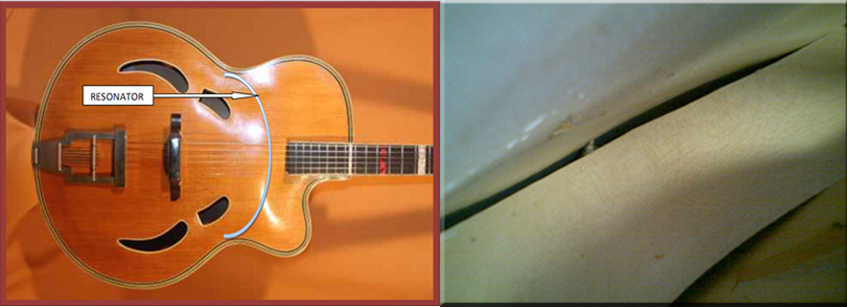-
Here’s a belated NGD, because it took some time to set up the guitar. I bought it as a project, but it wasn’t in bad shape at all. It only needed the neck straightened and some fret dressing (which I’m not happy about and I’m sure it’ll end up being a full refret, something I don’t know how to do and I won’t be trying with this one!).
It didn’t come too expensive because it had the headstock broken. It was fixed well, although not conspicuously. No grievances here.
This guitar is by German luthier Rodebald Hoyer, built in 1960. The holes are inspired by Lang, with whom Rodebald Hoyer shared his formative years. It is a lovely guitar with an amazing tone, quite bright and with plenty of overtones.
It has a wooden mechanism to compartimentase the guitar in two interconnected sound chambers.
Overall, a wonderful instrument! I’m very happy!









Sent from my iPhone using Tapatalk Pro
-
11-28-2022 06:01 PM
-
That looks beautiful! Crazy woodwork on the back of the neck.
"It has a wooden mechanism to compartimentase the guitar in two interconnected sound chambers."
Can you explain this more?
-
I think I made it sound a little more sophisticated than it really is. See the illustration found at Schlaggitarren. It is very clear:

Apparently, it makes the bottom of the body cylinder shaped, but allows air to move up the upper end of body too …
Sent from my iPhone using Tapatalk Pro
-
Very interesting, I haven't heard of an internal resonator on a guitar before. Banjos can have the resonator plate which changes the sound considerable, usually to make it louder and to be more directional.
R. Hoyer was in West Germany but the guitar has the Stauffer adjustable neck bolt, which I always thought was more of an East German technique.
-
It is indeed unusual.
As for the stauffer, he used this type of joint on his higher end guitars, but not on the lower end ones, so I guess he thought it was a better, but more laborious solution.
Sent from my iPhone using Tapatalk Pro
-
The Macaferri design has an internal resonator, as of course do Dobros and other resophonic guitars. I own a Michael Dunn “Mystery Pacific” grande bouche model based on the Macaferri which is very loud.
 Originally Posted by supersoul
Originally Posted by supersoul
-
Lovely guitar. My Broadway has the internal tone ring as well. I don't think it does much other than add a bit of weight.
Last edited by Hammertone; 11-30-2022 at 03:27 PM.
-
Lovely Broadway! I don’t know if it does much, but the tone of this one is definitely different from a similar sized Rod Hoyer I’ve got. Similar construction (solid spruce top, laminate back, stauffer joint). It’s also lovely, only a little different .
Its neck is much wider than the Solist, which is on the narrow side. Still comfortable.
Sent from my iPhone using Tapatalk Pro
-
As often with German guitars the neck and headstock are an acquired taste but the woodwork is impressive. Does this model also have the thick plates that many Schlaggitarren have?
There are preciously little soundsamples of these German instruments, probably the main reason I didn't buy one. So if you'd consider to record some representative sound bites (different styles and techniques ) that would be appreciated!
) that would be appreciated!
-
German guitars can have all sorts of thickness on their plates. I’ve got guitars with very light (they tend to be East German, for some reason) and very thick plates. This one has a thick top plate (thicker on the bass side), something that doesn’t prevent it from sounding excellent even playing fingerstyle without nails (obviously at a lot lower volume). As for sound samples, give me a couple of days and I’ll see what I can do.
Sent from my iPhone using Tapatalk Pro
-
I know, they can also have all kinds of bracing (including none at all, apparently). If well carved a thick top isn't a problem for a nice sound quality even fingerstyle, it's just the quantity that will be "somewhat" less.
 Originally Posted by xavierbarcelo
Originally Posted by xavierbarcelo

Looking forward to hearing this one!
-
I love the way those old German guitars look. So vibey!
Love to hear the guitar...




 Reply With Quote
Reply With Quote







Thomastik-Infeld Jazz Swing 112
Today, 02:35 PM in For Sale